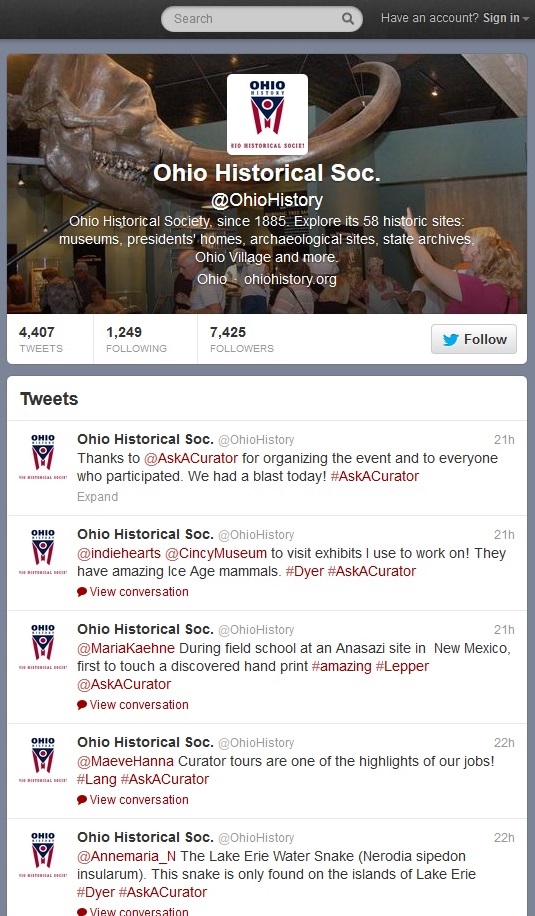 Yesterday was “Ask a Curator Day” and the Ohio Historical Society was one of 622 museums from 37 different countries who joined in the fun.
Yesterday was “Ask a Curator Day” and the Ohio Historical Society was one of 622 museums from 37 different countries who joined in the fun.
Most of our curators participated, but History Curator Emily Lang collected and posted our responses. I sort of forgot the whole point of Twitter and typed long, involved answers to some of the questions, so Emily had to edit down many of my responses. (Thanks, Emily!)
Just for fun, I thought I’d post a few of the questions I was asked along with my more verbose and unedited responses.
If you have any questions you’d like to ask, you don’t have to wait for the next “Ask a Curator Day.” Just post them as a comment to this blog.
Brad Lepper, Curator of Archaeology
___________________
Q: What is the most ‘ancient’ historical item or destination in Ohio?
A: The most ancient item in the [Ohio Historical Society’s] Archaeology collection would have to be one of the several Clovis stone spear points from various parts of the state. These are around 13,000 years old and some of them were used to hunt mammoths and mastodons during the Ice Age.
___________________
Q: The most mundane and most rewarding part of the job?
A: Archaeology is a mix of excruciatingly mundane daily tasks and infrequent, but exhilarating discoveries. The most mundane part of the job is labeling and otherwise accounting for every single chip of stone or pottery from every site in our collection. Its absolutely vital that we do this, but you feel more like an accountant than an archaeologist when youre entering all of this minutia into an Excel database. The most rewarding part of the job is getting dirty excavating archaeological sites, discovering long forgotten artifacts and traces of ancient campfires and using all of that information youve entered into those databases to fill in the blank pages of Ohios history.
___________________
Q: What is the most important or valuable artifact you have ever held in your hands? How did it feel?
A: As Curator of the Ohio Historical Society, Ive had the opportunity to hold in my hands a number of truly magnificent and important artifacts from the Adena Pipe (now Ohios State Artifact) to a 13,000-year-old Clovis point. I dont know how I could possibly rank them in importance and I wouldnt consider putting a monetary value on any of them. They all are priceless links to ancient lives.
The most important ancient object Ive ever laid my hands upon, from an entirely personal perspective, was at an Anasazi (or Ancestral Puebloan) site in southern New Mexico. It was my college field school and we were digging in a masonry-walled room of a pueblo and when we got near the floor it became evident that there had been a doorway that, at some point in the history of this place, the people living there had walled-up. They had carefully stacked the roughly-shaped stone slabs in the doorway and sealed it over with clay. Then, someone, perhaps 900 to 1,000 years ago, had placed their right hand in the clay leaving a clear imprint. You could even see the fingerprints. I got to be the first person to place my hand in that freshly uncovered handprint. It felt like shaking hands with that ancient American Indian across all those centuries and I felt an almost electric connection to that person who had lived in the same space I was now excavating and the experience was unlike anything Ive ever felt either before or since. So, for me, that was the most important artifact Ive ever touched.
___________________
Q: What exhibition have you always wanted to curate but never had the chance?
A: Someday, Id love to do an exhibit focused on the iconography of Hopewell art that would tie the art directly to the particular earthwork sites at which the individual pieces were found. I view these objects metaphorically as the words of the stories of these ancient people and each one of these magical places the Newark Earthworks, Fort Ancient, and so on have their own unique stories to tell.
The Shaman of Newark, for example. It used to be called simply the Wray figurine, which basically signifies only that it was once owned by a man named Wray. But its not just an evocative stone sculpture. Its a story that belongs to a place the Newark Earthworks, which is why Ive begun to refer to it as the Shaman of Newark. So, in a small way, Ive already begun to develop that exhibit.